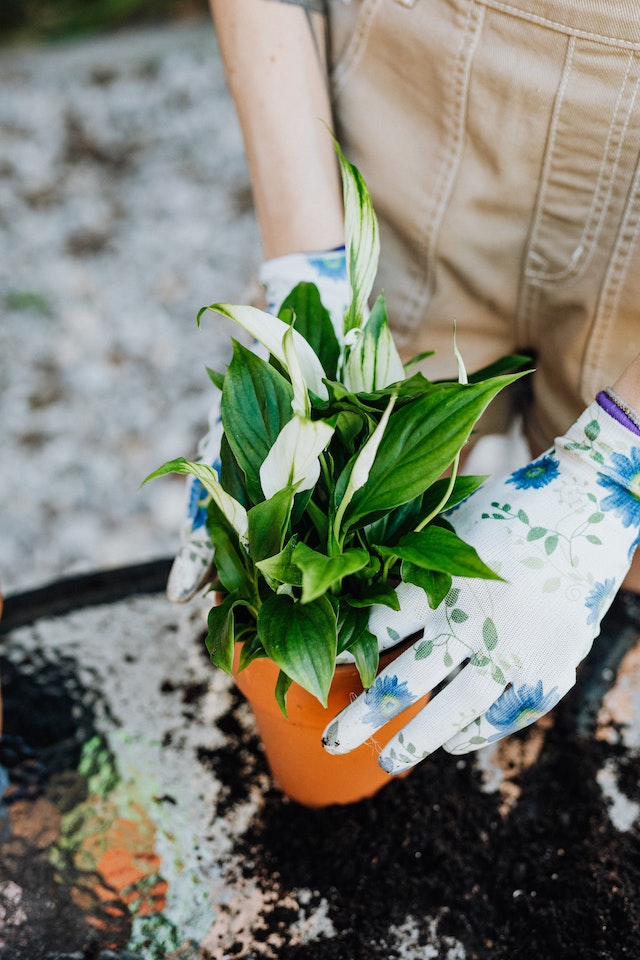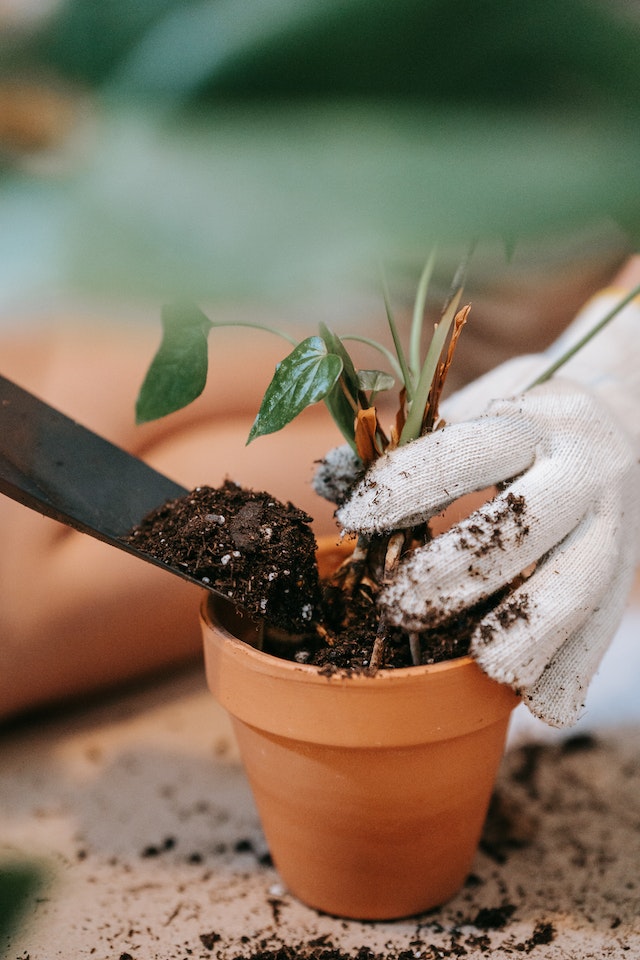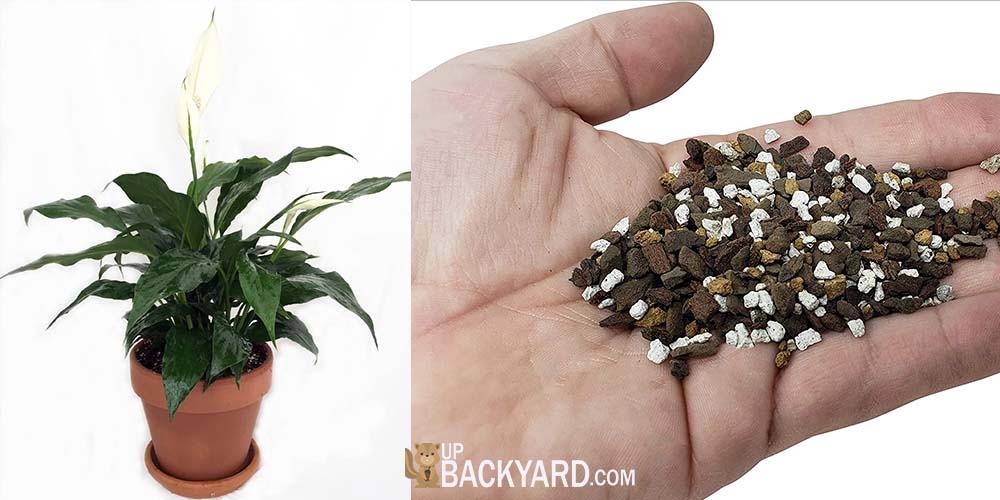Peace lilies are beautiful and soft plants that make great gifts. Their stunning green foliage is accented by the white flower that arises from it.
While peace lilies are not actually lilies, they do look a lot like them. The white flower reminds us of the white flag of surrender, thus the name peace lily.
Whether you picked one up yourself at your local garden center or were gifted one of these stunning plants, you want to be sure you care for it properly.
When the plant needs to be repotted either from growth or an accidental breaking of the pot, you may wonder what type of soil can be used to grow a peace lily.
Can You Use Cactus Soil For Peace Lily Plants?
Peace lily plants love cactus soil because of how well the cactus soil mixture drains and aerates.
Cactus soil is also slightly acidic, which helps peace lilies thrive. While you can use any well-draining soil mixture for a peace lily plant, there is no doubt that a premixed bag of cactus soil will serve you perfectly fine.
How Do I Care For Peace Lily?

Peace lily plants make wonderful houseplants for both beginner and experienced plant owners alike.
The single petal flower makes a peace lily easily identifiable and it may seem like everyone you know has one of these beauties in their plant collections.
Part of the allure of peace lilies is how easy they are to care for. Even the most inexperienced houseplant owner can keep a peace lily thriving with just a few tips and tricks to remember.
Light
Peace lilies, like most flowering plants, love bright indirect light. Placing your peace lily in an east or north facing window is a great way to ensure they get the light they need.
However, placing them directly in a south facing window could give them too much bright light and they can shrivel and become stressed.
If you notice your peace lily is not flowering as much as you would like, it most likely needs more light.
Sunlight is how a plant performs photosynthesis. This is the process in which the plants take the sun’s energy and turn into energy for themselves.
Growing flowers requires immense energy. Exposing your plant to more light will most likely result in bolder and more frequent flowers.
Watering
Watering is important when it comes to peace lilies. While they need water to survive, they do not like to sit in wet, soggy soil.
It is best to water thoroughly once every 5-8 days. Allow the soil to dry out well in between watering sessions. This helps prevent root rot or other fungal diseases from settling in the overly wet soil.
Peace lilies will let you know when they are thirsty. They can be considered dramatic and droop when they need water.
If you notice the plant looks a little sad, give it a good water session. It should perk right back up!
Peace lilies can also be temperamental and picky about water. Some tap water has minerals that may hurt them, it is best to use filtered water at room temperature when watering your peace lily.
Humidity & Temperature
Peace lilies are actually tropical plants by nature. This means they love humidity!
Running a humidifier for your plants throughout the day can help them feel at home.
They sell small, shelf-sized humidifiers especially for plants, but even a whole room one from a pharmacy or big box store will work as well. Be sure to use distilled water to avoid mineral buildup in the humidifier.
While it can be hard to mimic the same environment in your house, it is essential to keep the temperature above 60°F (16°C).
Also, be sure to keep them away from windows in winter. The glass is cold and can cause frostbite on your plant’s leaves.
Peace lilies thrive in temperatures around 70°F (21°C) or above.
Fertilizing
Peace lilies are not plants that need a lot of fertilizing. If you want to encourage a lot of growth in the spring, go ahead and fertilize with a balanced houseplant fertilizer once or twice giving 6 weeks between doses.
Do not fertilize a freshly repotted houseplant!
Changing out the soil is another way to give the plant a boost of nutrients without using fertilizer.
It is best to repot once a year as the plant begins to outgrow its current living space. You can tell it is time to repot once the roots begin poking out of the drainage holes in the pot.
Dust the Leaves
Peace lilies have larger leaves that will collect dust. Once every other week, use a damp cloth to wipe the leaves clean.
This helps prevent build up and allows the plant to perform photosynthesis more efficiently.
You might also like: Does Lavender Attract Bees? (Here’s The Answer)
How to Pot Peace Lily?

When it comes time to repot a peace lily, there are a few things you need to consider.
Choosing a pot and a pot size are important, but so is which type of soil to use and when to repot the plant.
While the process itself is relatively straight forward, choosing the right products allow for a successful transfer and thriving houseplant.
When to Repot
There are many reasons you may want to repot a peace lily plant. The first is that the plant was knocked over and the pot broke or cracked.
Another reason could be that the plant has grown too much and is now too small for the current pot.
Growing in a pot that is too small can negatively impact the plant and cause it to die.
A final reason is that the plant had a bit of a “summer vacation” and now it is time to bring it back in.
Since peace lilies are tropical, they love the hot humid summers outdoors, but before you bring them in for the fall, be sure to change the soil.
Bugs may have made homes inside the pot and you do not want to bring that into your home.
Choosing a Pot
There are two things you need to look at when choosing a pot. The first is the size.
You want to repot in a pot that is at least one inch wider than the previous pot. This gives the plant enough room to grow without feeling too insecure.
Going much larger than the initial pot inhibits growth as peace lilies prefer to be tightly secured in their pots.
The next thing you want to be sure of is that the pot has good drainage. There should be multiple drainage holes on the bottom of the pot.
If there are not enough to ensure proper drainage, drill a few more in. Stagnant water at the bottom of a pot can lead to root rot or other problems.
Peace lilies especially love well-drained soil and will die if the soil is kept too moist.
Choosing Soil
Peace lilies need balanced, well draining soil that also allows for proper air flow. They thrive in tropical places where the soil is not heavy or weighed down.
If you want to purchase a bag of soil mix for your peace lily, choosing a cactus or succulent mixture is a great option.
These are full of peat, charcoal, some sand, perlite, expanded clay, and charcoal in addition to minerals and vitamins needed for plants to thrive. You can find these types of soil at any garden or plant store.
Be sure to choose one that says succulent to cactus on it to ensure that you are not choosing a bag of soil that is too heavy or rich for your peace lily.
Making Soil
You can also DIY your own soil mixture for your peace lily.
If you are someone who has many plants or already has some garden soil laying around, it may be better or more convenient for you to make the proper soil mixture.
For peace lilies, soil with decomposed leaves, clay turf, well composed manure, river sand, charcoal, and coconut fibers all make great additions to your soil mixture.
Finely ground mulch and sand add space between the soil allowing for air and water to pass through easily.
Fill the bottom of your pot with gravel to help keep the bottom soil dry, even if the drainage holes are not the best.
It is a good idea to grow your peace lily in a plastic garden pot and place that pot in a decorative pot. This makes it easier to care for and many decorative pots do not have drainage holes.
Key Takeaways
Peace lilies are beautiful and abundant houseplants that add a touch of elegance to any home. Whether you were given one as a gift or picked one up yourself, it is always good to know how to tailor your care for the plant.
Peace lilies are tropical plants, so they need lots of sun, warmth, humidity, moisture, and well-draining soil.
Growing your peace lily in cactus soil is a great way to ensure that they have the base they need to establish healthy roots.
You can buy soil premixed in bags from a local garden center or make your own with homemade ingredients.
Now, you are ready to take on a peace lily plant and help it thrive. Be sure to enjoy the stunning elegance of those single petal white flowers!
